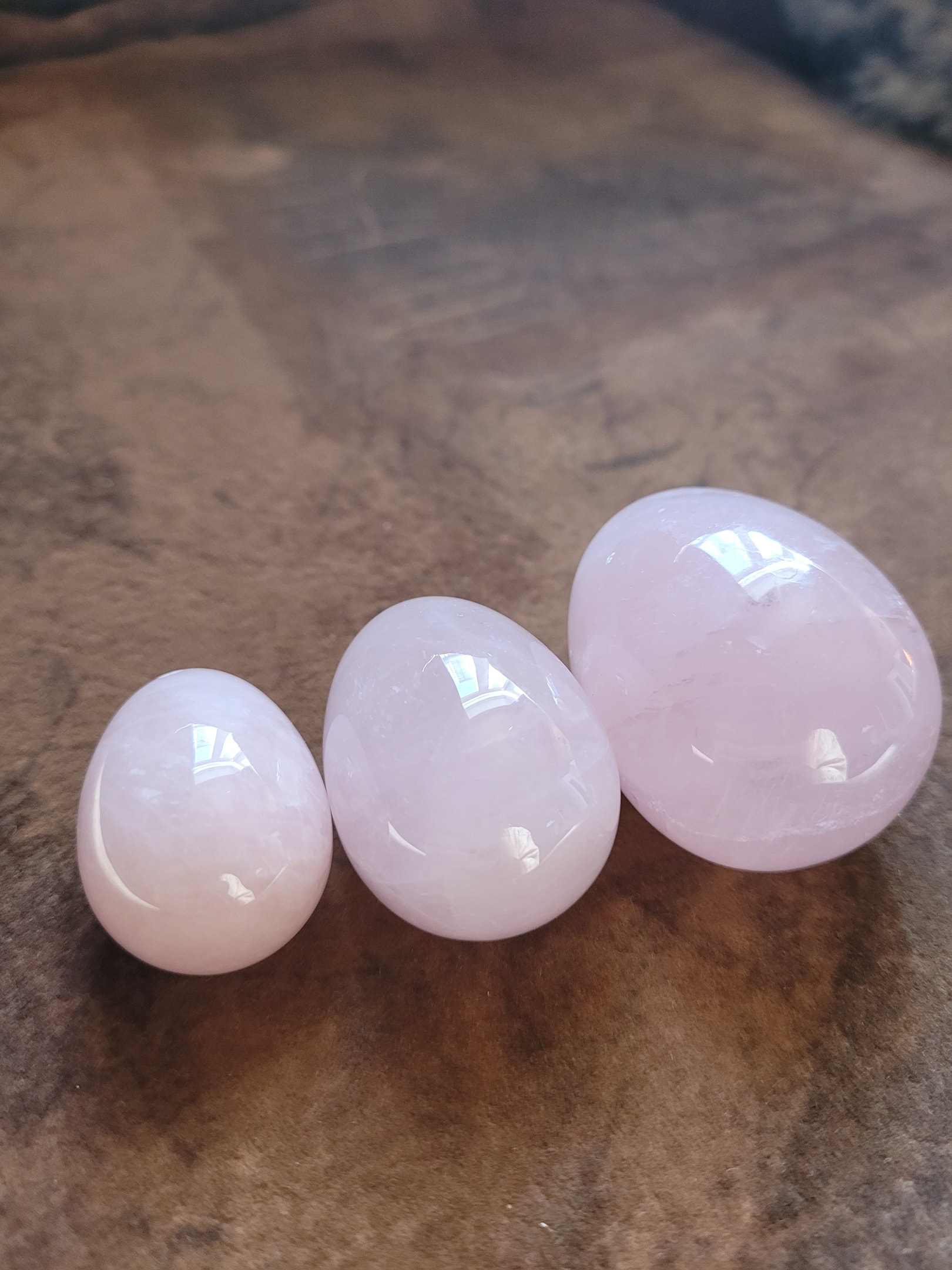
Table of Contents ▾
The size of your yoni egg determines how effective your practice will be. When the egg fits well, your pelvic floor can engage properly and you can feel it, hold it, and build strength. If it’s too small, it might slip out or feel like nothing. Too large, and your body may resist or tighten unnecessarily. But the right size gives you more tone and more sensation.
At WAANDS™, we offer three specific sizes designed to meet you where you are. The medium egg, measuring 43 by 30 millimeters, is our most popular and usually the best place to start. If you’ve given birth vaginally or feel like you’ve lost tone, the large egg, 50 by 38 millimeters, provides more surface area and weight, giving your muscles something substantial to grip and respond to.
And if you’re further along in your practice, or have a petite vaginal canal, the small egg, 35 by 25 millimeters, offers a more advanced challenge. It requires refined muscle control and helps you increase awareness and precision.
Why Yoni Egg Size Matters in Real Practice
The size of your yoni egg is the difference between muscles that can feel and engage with it, and muscles that can’t respond at all. When the egg is too small, it often feels like nothing is there. A woman might insert it and try to do a Kegel, but there’s no resistance. The egg moves around too freely or slips out during simple movements like shifting from sitting to standing. Instead of activating the right muscles, the body might react by tensing the thighs or holding the breath just to try to sense it - without actually engaging the pelvic floor where the work is supposed to happen.
When the egg is too large, it can press at the vaginal opening in a way that creates a pinching or stretching sensation. The tissue feels like it’s being forced open, and the natural reaction is for the pelvic floor to tighten and brace rather than lift and respond. A woman might notice her breath getting short, her lower belly tensing, or a feeling of pressure that makes her want to remove the egg. That’s a sign that the egg is too big to allow the pelvic floor to respond with strength and tone.
The right size egg fits comfortably inside with a sense of fullness that’s easy to feel but not overwhelming. It stays in place when standing or moving gently around the room. During exercises, the egg lifts when the muscles engage and drops back down when they relax. There’s a clear difference between tension and release. The body knows exactly where the egg is, and that awareness helps train the muscles to respond consistently.
Overview of Available Sizes
Large Yoni Egg (50 × 38 mm)

The large yoni egg is for when your body needs more to work with. If you can’t feel a tampon or a finger once it’s inserted or if you’ve never done pelvic floor work before, this is the size to start with.
It’s the most physically noticeable egg in terms of sensation. Once inserted, it sits close to the vaginal walls and creates natural feedback, you’ll feel its weight without having to squeeze. Your body registers it even if your muscles are weak or disengaged. You don’t need skill or strength to begin.
This size is especially useful if you’ve had a vaginal birth (particularly with tearing or stitches), if you leak a little when sneezing or jumping, if you feel internal heaviness by the end of the day, or if you find it hard to identify or isolate your pelvic floor muscles. The egg gives your body a clear shape to respond to, which can start rewiring your awareness and coordination.
Medium Drilled Yoni Egg (43 × 30 mm)
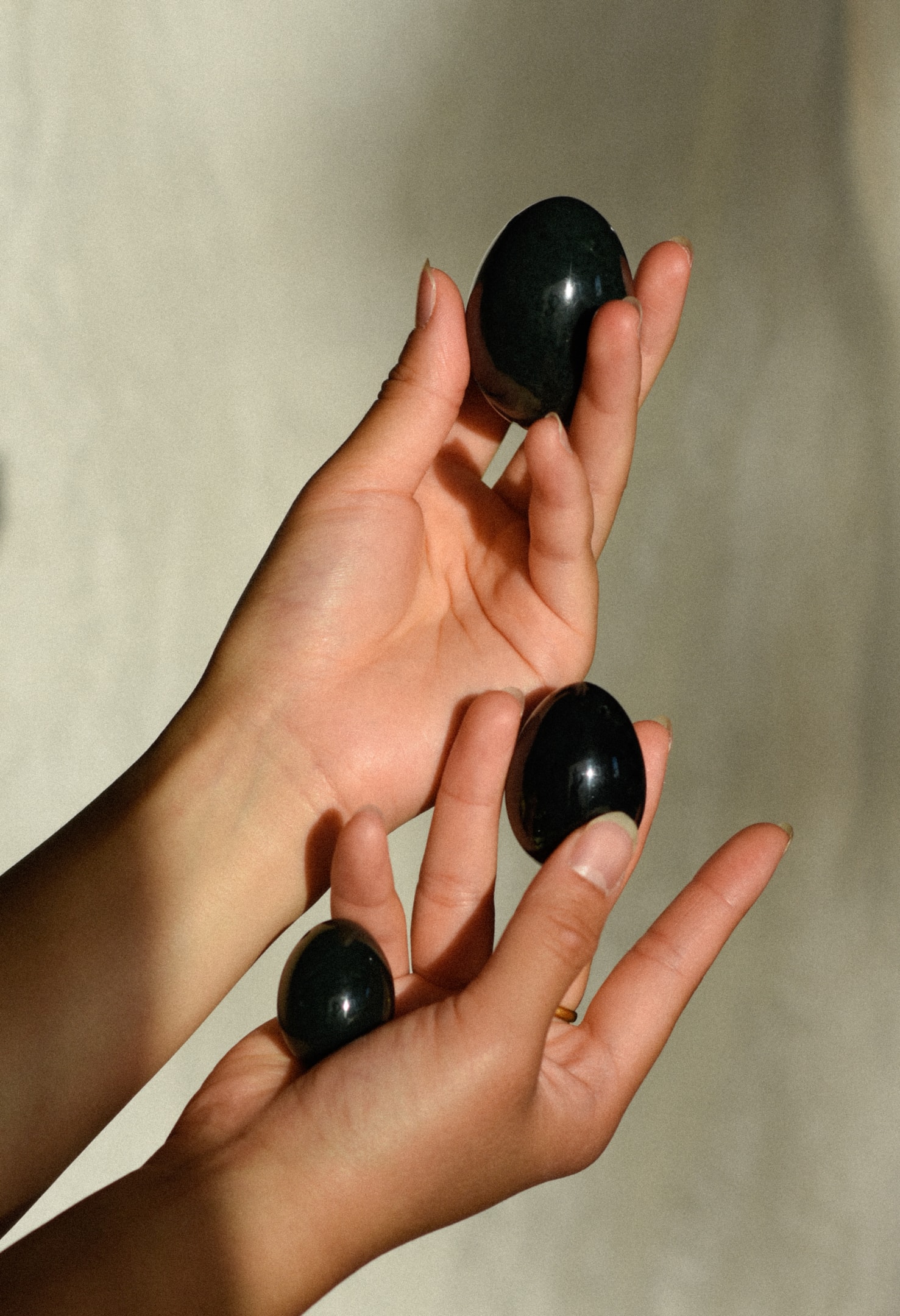
The medium yoni egg is for women who already have some sense of pelvic floor engagement. It is often advised for your first yoni egg. If you can feel a subtle lift when you do a Kegel, or if you’ve practiced internal awareness techniques like vaginal steaming or breath-based core exercises, this size gives you enough feedback to build strength and coordination.
It’s light enough that the muscles need to activate intentionally to hold it in place. You’ll feel it shift slightly during standing or gentle movement, which helps train your pelvic floor to respond to everyday activities. The drilled design lets you thread a string through it for easy removal and to experiment with gentle resistance work.
This size is especially helpful if you want to practice exercises like quick flicks or slow holds while standing or walking, or if you’re looking to develop more precise control. The medium egg creates just enough presence to keep you connected, without overpowering the experience.
Small Yoni Egg (35 × 25 mm)
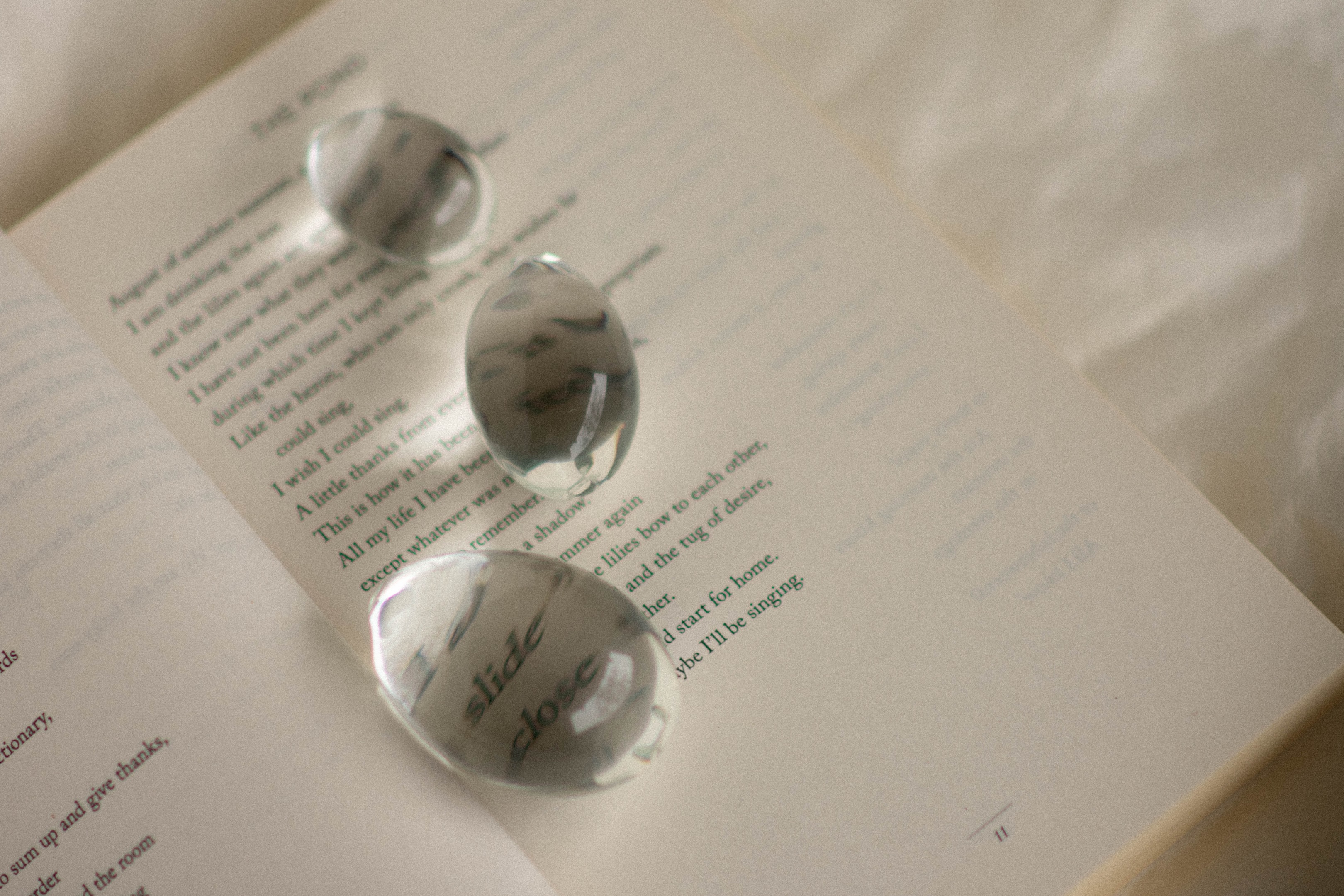
The small yoni egg is for advanced training when the pelvic floor is already responsive and coordinated. If you can hold a medium egg in place easily during standing, walking, or light movement, and feel it clearly when you engage, this size gives you the next level of challenge.
It’s light and narrow, so it requires refined muscle control to keep it in. If the pelvic floor is not fully engaged or if other muscles (like the glutes or abs) take over, the egg will slip out. This is why it’s not recommended for beginners or for those still building basic tone.
The small egg is best for short, targeted practices focused on precision. It’s also occasionally used by women with a naturally tight vaginal opening who find the medium egg uncomfortable to insert. In that case, it’s best used lying down, without forcing the muscles to hold it in - giving the tissue time to adapt naturally.
Key Factors That Should Influence Your Choice
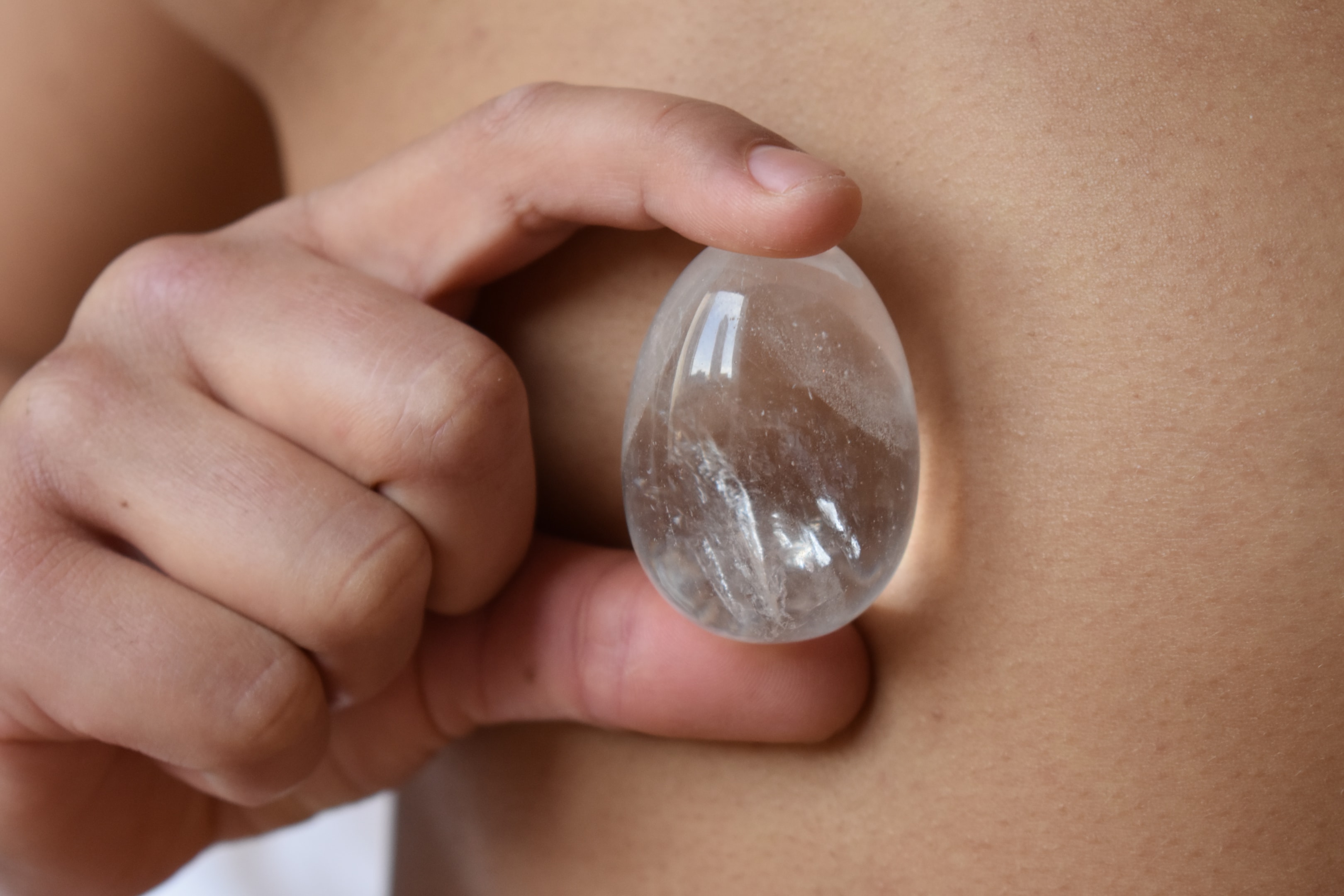
Pelvic Floor Health History
Your pelvic floor condition directly affects how your body interacts with a yoni egg. If your muscles are weak, tense, or disconnected, the egg won’t be used the same way as it would in a body with strong, responsive tone.
Scar tissue, prolapse, nerve damage, or chronic holding patterns can all change how much sensation or control you have. That means you’ll need to choose a size that either supports engagement without strain or helps restore basic awareness.
Experience with Internal Work
If you’ve never done internal practices, no Kegels, no wands, no pelvic floor therapy, your body won’t automatically know how to respond to a small or even medium-sized egg. If this is your first time doing any sort of pelvic awareness work, start with an egg that’s easy to find and easy to track. A medium or large egg gives you something your muscles can feel from the beginning.
Ability to Feel and Engage Your Vaginal Muscles
True pelvic floor engagement feels like a lift from deep inside the vaginal canal, not a squeeze in your thighs or a clench in your abs. If those are the first muscles that fire when you insert the egg, you’re compensating, and the coordination simply isn’t there yet. Using an egg that’s too small will only magnify that disconnect.
Sensitivity or Numbness
If you insert the egg and can’t tell where it is, no weight, no pressure, no sense of shape, your pelvic floor isn’t registering it. This usually shows up as the egg slipping out without warning, sitting inside without sensation, or disappearing into silence the moment it’s in. That’s a clear sign your body isn’t getting enough input to engage. You should be able to feel the egg resting against at least one part of the vaginal wall, even when you’re lying down or walking around. If you have to keep squeezing to stay aware of it, it’s not the right size for where your body is at right now.
Yoni Egg Size Comparison Chart
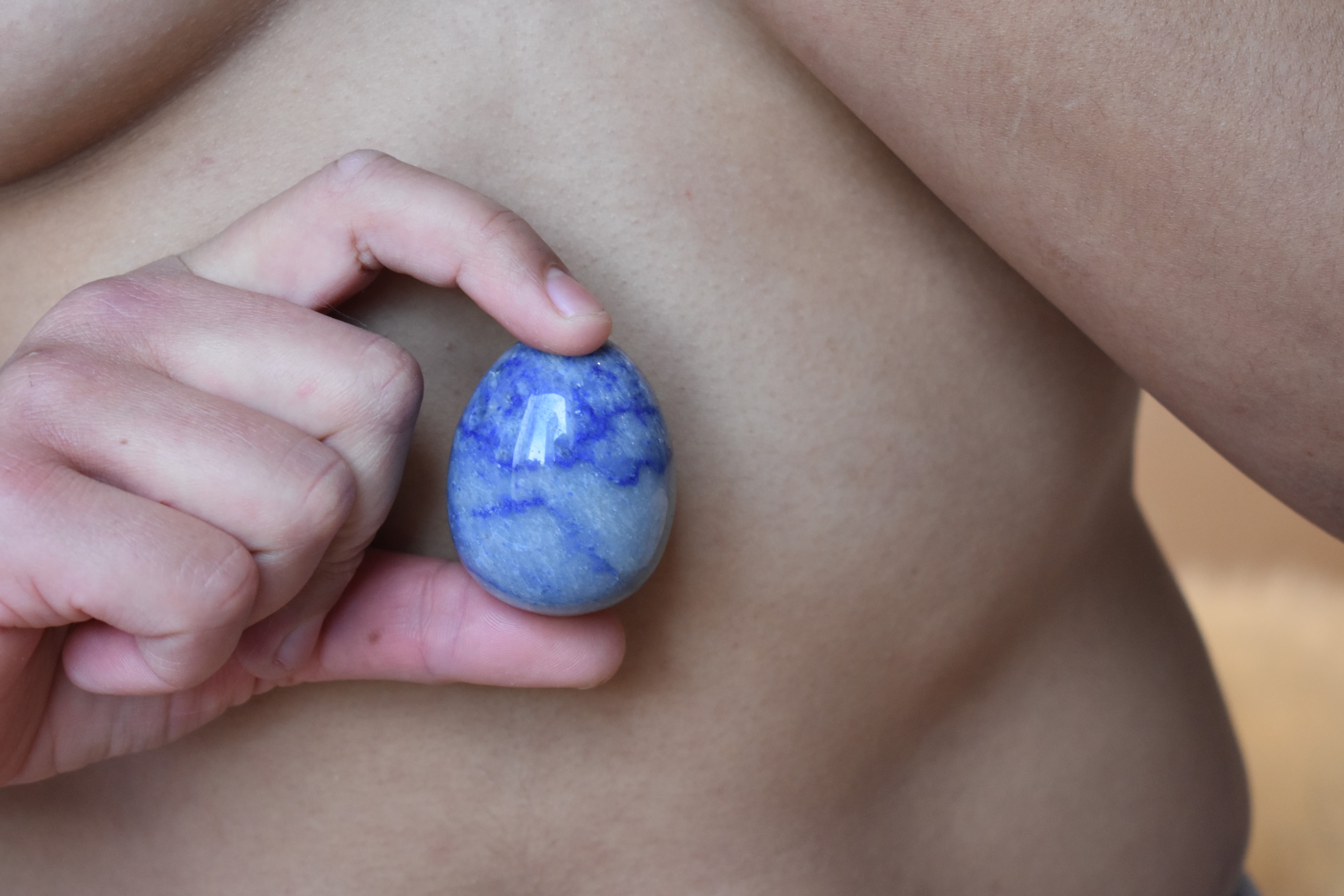
|
Yoni Egg Size |
Best For |
Muscle Feedback |
Effective Exercises (with Yoni Egg) |
|
Large (50 × 38 mm) |
Postpartum recovery, rebuilding tone, reconnecting with sensation |
High, felt immediately without needing to contract |
- Passive Breath Hold (lie down, focus on breath + awareness) - Foundational Kegel (slow 5–10 sec lift + full release) - Pelvic Clock (lying down, gently rock pelvis forward/back/side to side with egg inserted) - Supine Butterfly Breathing (knees open, egg inserted, focus on opening with breath) |
|
Medium (43 × 30 mm) |
General strengthening, average tone, muscle coordination |
Moderate, requires conscious engagement to feel movement |
- Quick Flicks (rapid contract + release in reps of 10) - Elevator Squeeze (3-level squeeze: ⅓, ⅔, full… then release step by step) - Standing Kegel Hold (10 sec hold while standing still) - Walking with Awareness (move around home while noticing egg position) |
|
Small (35 × 25 mm) |
Advanced tone, refined control, deep sensitivity training |
Low, requires precise, isolated pelvic engagement |
- Targeted Micro-Lifts (tiny internal pulses with full awareness) - Isolated Side Wall Contraction (contract right/left side of vaginal wall separately) - Standing Squat Pulse (mini squats with egg held inside) - Seated Rock & Engage (rock pelvis on chair or ball, contracting gently at peak tilt) |
What Beginners Get Wrong About Yoni Egg Size
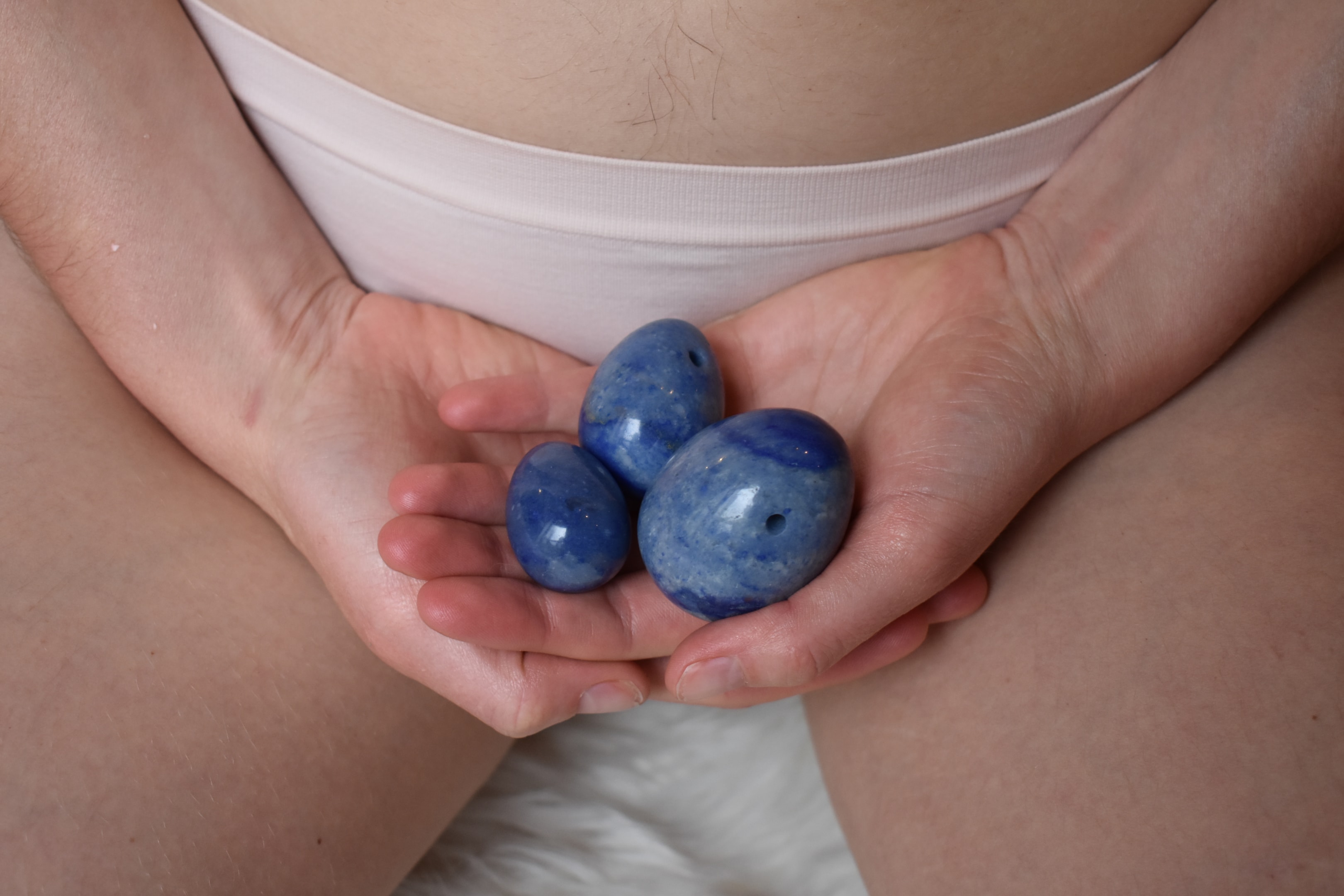
Trying to wear the egg for extended periods is one of the fastest ways to create fatigue, tension, or even dysfunction. It’s easy to assume that keeping the egg in longer will build more strength, but the pelvic floor doesn’t work that way. Like any muscle group, it responds best to cycles of engagement and release.
For beginners using a large egg, short sessions of 5 to 10 minutes lying down are often enough to start building awareness. This allows the body to register the egg’s presence without fatigue. As coordination improves, short standing exercises can be added - no more than 15 minutes at a time, with breaks between sets.
With a medium egg, women who have been practicing for a few weeks can work up to 15 to 20 minutes per session, focusing on slow holds, gentle movements, and short walks around the house. It’s important to keep the practice active by moving with intention rather than treating the egg like a tampon that just sits there.
A small egg is for advanced users, and even then, it’s best to keep sessions under 10 minutes, especially during dynamic exercises or precision drills. The smaller size requires more muscle control to hold in place, and overuse can easily lead to tension patterns that sabotage progress.
Sleeping with the egg overnight is never recommended, no matter how advanced the practice. Extended use can lead to numbness, over-clenching, and difficulty distinguishing between holding and releasing.
Squeezing Without Awareness
New users often hear “strengthen your pelvic floor” and immediately try to squeeze as hard as possible, but squeezing isn’t the same as engaging. Most women who try to grip the egg end up using their thighs, glutes, or abs instead. Without feedback from the right size egg, the pelvic floor gets bypassed. Real engagement feels like a subtle lift from inside the vaginal canal.
Forgetting the Role of Breath
Breath is essential in yoni egg practice. Your diaphragm and pelvic floor work together. When you inhale, your pelvic floor descends. When you exhale, it lifts. If you’re holding your breath while trying to contract, you cut off that rhythm and lose the awareness you need.
Rushing the Progression
Rushing to a smaller egg before the body is ready doesn’t speed up results. When the egg is too light or too narrow for your current tone, the pelvic floor can’t hold it in place. That leads to immediate compensation. Your thighs tighten, glutes clench, and lower belly hardens. Instead of isolating the vaginal muscles, the body tries to use everything else to keep the egg from falling out.
Over time, this compensation creates tension patterns that show up as discomfort during sex, pain when sitting, or even chronic pelvic pain. The brain starts to link yoni egg practice with strain and confusion instead of support and connection. The pelvic floor can actually weaken from bearing down or pushing out the egg, leading to leaks, heaviness, and a sense of disconnection from the entire area.
Progress happens when the egg matches what your body can hold, lift, and feel. Rushing that step forces your body into defense mode - bracing, holding, and gripping instead of building real tone. A smaller egg only works when the muscles can hold it without help.
Signs You're Ready To Size Down To A Small Egg
-
The current egg stays in place during standing, walking, and gentle squats without any need to grip or tense the surrounding muscles.
-
The egg doesn’t slip toward the opening or push outward during movement.
-
The thighs, glutes, and lower belly remain relaxed with no compensation needed to keep the egg in.
-
During contraction exercises, the egg lifts clearly when the pelvic floor engages and settles back when the muscles release.
-
There’s a distinct sensation of a full lift, a partial lift, and a complete release—each stage feels separate and intentional.
-
By the end of a flick set or slow elevator squeeze, the vaginal wall still feels engaged and responsive, not fatigued or confused.
-
The egg starts to feel too passive, staying in place regardless of movement or exercise, and muscle contractions no longer create noticeable change or challenge.
-
There’s a sense of consistent control, tone, and awareness, your body knows where to look and how to respond without hesitation.
Signs You Should Stay With A Medium Or Large Egg
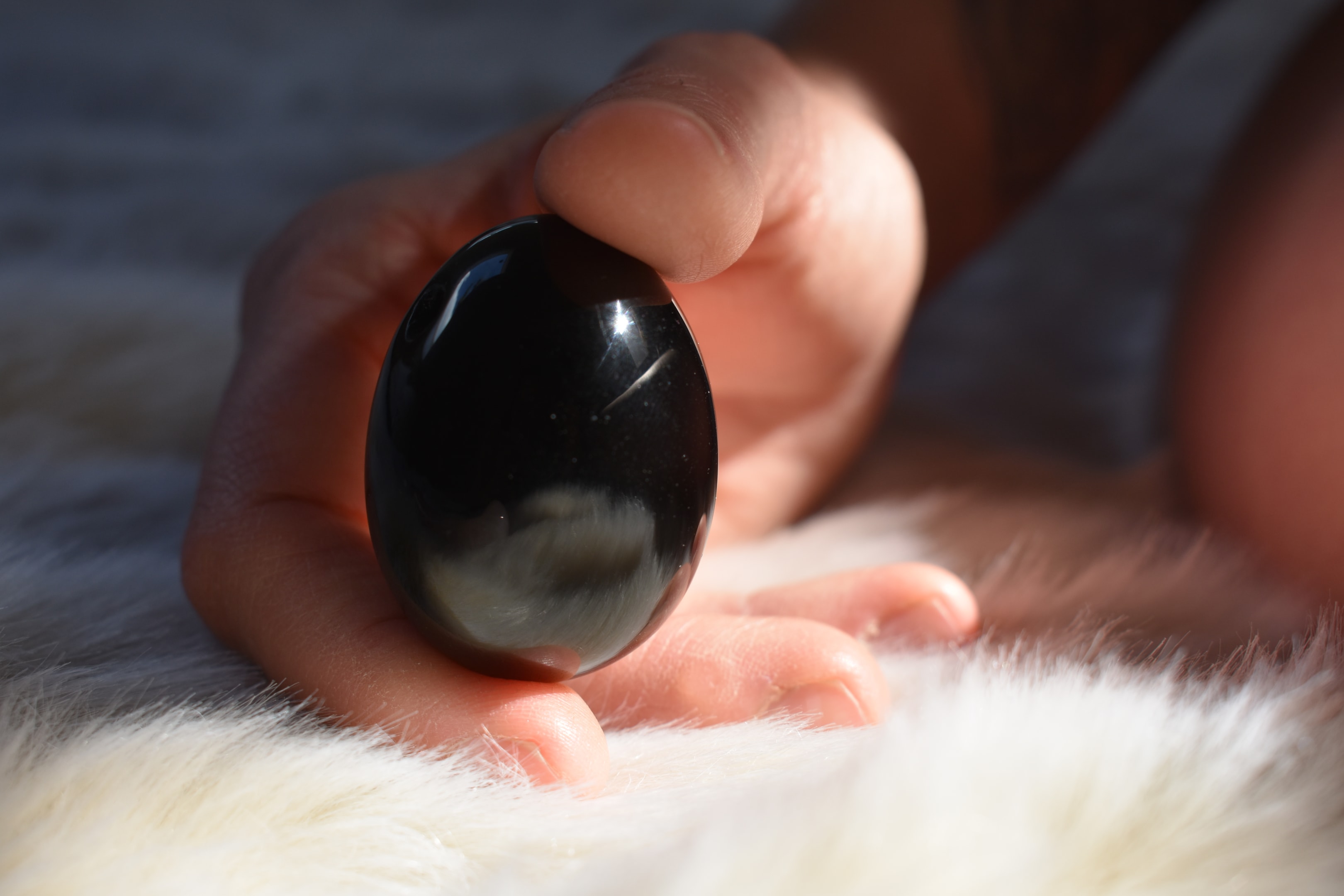
The body’s feedback is clear when the muscles aren’t yet ready for a smaller challenge. These are the physical signs that say: stay right where you are.
-
The egg shifts toward the vaginal opening during standing or slides out during light movement, showing the muscles aren’t yet holding consistent tone.
-
Contraction exercises like quick flicks or slow holds cause the thighs or lower belly to tense, indicating compensation instead of isolated pelvic floor engagement.
-
There’s no clear awareness of where the egg is, even during contraction, and the muscles feel disconnected from the egg’s position.
-
The egg stays passive or drops out during simple movements like walking or shifting from standing to sitting.
-
Some days the tone feels stronger, other days it feels weaker, with noticeable variation depending on stress, fatigue, or cycle.
-
The egg feels heavy, but there’s effort or confusion trying to keep it in, especially during dynamic movements or long holds.
-
The medium or large egg continues to provide contact and feedback that helps the body learn, even when tone shifts from day to day.
FAQ
What is the size of the yoni?
The yoni, or vagina, is a highly elastic and responsive organ that typically measures about 7 to 10 centimeters (2.7 to 4 inches) in length when unaroused, and can expand to around 11 to 13 centimeters (4.3 to 5.1 inches) or more when aroused. Its width varies, but the muscular walls can stretch significantly, accommodating various sizes during arousal, penetration, or childbirth.
Do yoni eggs make you tighter?
Yoni eggs support your body in reconnecting with the pelvic floor by offering weight and feedback that your muscles can engage with. This practice helps build tone, but the goal isn’t simply to “get tighter.” Instead, yoni egg exercises teach your body to lift, release, and coordinate – which develops strength and flexibility at the same time. A medium egg is especially helpful for building foundational tone and learning how to engage without gripping.
What stone is in the yoni egg?
Yoni eggs are made from a variety of beautiful and exotic gemstones, each with their own energetic and healing benefits. Some of the most popular yoni eggs include nephrite jade, a very healing stone known for its density and resilience. Nephrite jade energetically balances the root chakra and second chakra, helping connect the female physical body with grounding and safety. Rose quartz corresponds strongly with the heart chakra, softening self-criticism and enhancing connection to one’s own body. Black obsidian is a very protective stone that supports releasing stored emotions and creating boundaries in the female reproductive system.
Can I leave a yoni egg in all day?
It’s not recommended to keep a yoni egg inside for long periods of time, even if it’s a drilled egg. The pelvic floor muscles need cycles of engagement and release to build tone safely. Leaving the egg in all day or overnight can cause the muscles to overcompensate or tense up, leading to fatigue and confusion in the pelvic floor. Instead, aim for shorter, intentional sessions with your medium-size yoni egg, focusing on yoni egg exercises like quick flicks, elevator squeezes, or breath holds. This allows the muscles to engage fully, then rest, giving the practice the clarity it needs to work.
